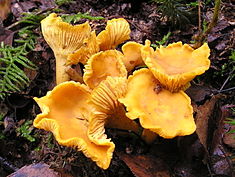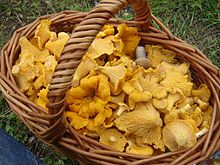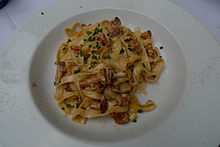- Chanterelle
-
Cantharellus cibarius 
Scientific classification Kingdom: Fungi Phylum: Basidiomycota Class: Agaricomycetes Order: Cantharellales Family: Cantharellaceae Genus: Cantharellus Species: C. cibarius Binomial name Cantharellus cibarius
Fr. (1821)Synonyms Species synonymy[1]- Agaricus cantharellus L. (1753)
- Merulius cantharellus (L.) Scop. (1772)
- Cantharellus vulgaris Gray (1821)
- Merulius cibarius (Fr.) Westend. (1857)
- Cantharellus rufipes Gillet (1878)
- Cantharellus cibarius var. amethysteus Quél. (1883)
- Cantharellus cibarius var. rufipes (Gillet) Cooke (1883)
- Cantharellus amethysteus (Quél.) Sacc. (1887)
- Craterellus amethysteus (Quél.) Quél. (1888)
- Craterellus cibarius (Fr.) Quél. (1888)
- Merulius amethysteus (Quél.) Kuntze (1891)
- Alectorolophoides cibarius (Fr.) Earle (1909)
- Chanterel cantharellus (L.) Murrill (1910)
- Cantharellus edulis Sacc. (1916)
- Cantharellus pallens Pilát (1959)
- Cantharellus cibarius var. amethysteus (Quél.) Cetto (1987)
Cantharellus cibarius Mycological characteristics 
ridges on hymenium 
cap is infundibuliform 
hymenium is decurrent 
stipe is bare 

spore print is yellow
to cream
ecology is mycorrhizal 
edibility: choice Cantharellus cibarius, commonly known as the chanterelle, golden chanterelle or girolle, is a fungus. It is probably the best known species of the genus Cantharellus, if not the entire family of Cantharellaceae. It is orange or yellow, meaty and funnel-shaped. On the lower surface, underneath the smooth cap, it has gill-like ridges that run almost all the way down its stipe, which tapers down seamlessly from the cap. It has a fruity smell, reminiscent of apricots and a mildly peppery taste (hence its German name, Pfifferling) and is considered an excellent edible mushroom.
Contents
Distribution
Chanterelles are common in northern parts of Europe and North America, including Mexico, in Asia including the Himalayas,[2] and in Africa including Zambia.[3] Chanterelles tend to grow in clusters in mossy coniferous forests, but are also often found in mountainous birch forests and among grasses and low-growing herbs. In central Europe, the golden chanterelle is often found in beech forests among similar species and forms.[4]
At one time, all yellow or golden chanterelles in western North America had been classified as C. cibarius. However, using DNA analysis, they have since been shown to be a group of related species. In 1997, the Pacific golden chanterelle (C. formosus) and C. cibarius var. roseocanus were identified,[5] followed by C. cascadensis in 2003[6] and C. californicus in 2008.[7]
Biochemistry
Chanterelles are relatively high in vitamin C (0.4 mg/g fresh weight),[8] very high in potassium (about 0.5%, dry weight),[9] and among the richest sources of vitamin D known, with ergocalciferol (vitamin D2) as high as 2500 IU/100 grams fresh weight.[10] Scientific research has suggested that the golden chanterelle may have potent insecticidal properties that are harmless against humans and yet protects the mushroom body against insects and other potentially harmful organisms.[11]
Culinary use
Though records of chanterelles being eaten date back to the 1500s, they first gained widespread recognition as a culinary delicacy with the spreading influence of French cuisine in the 1700s, where they began appearing in palace kitchens. For many years, they remained notable for being served at the tables of nobility. Nowadays, the usage of chanterelles in the kitchen is common throughout Europe and North America. In 1836, the Swedish mycologist Elias Fries considered the chanterelle "as one of the most important and best edible mushrooms."[4]
Chanterelles as a group are generally described as being rich in flavor, with a distinctive taste and aroma difficult to characterize. Some species have a fruity odor, others a more woody, earthy fragrance, and others still can even be considered spicy. The golden chanterelle is perhaps the most sought-after and flavorful chanterelle, and many chefs consider it on the same short list of gourmet fungi as truffles and morels. It therefore tends to command a high price in both restaurants and specialty stores.[12]
There are many ways to cook chanterelles. Most of the flavorful compounds in chanterelles are fat-soluble, making them good mushrooms to sauté in butter, oil or cream. They also contain smaller amounts of water- and alcohol-soluble flavorings, which lend the mushrooms well to recipes involving wine or other cooking alcohols. Many popular methods of cooking chanterelles include them in sautés, soufflés, cream sauces, and soups. They are not typically eaten raw, as their rich and complex flavor is best released when cooked.[4]
Chanterelles are also well-suited for drying, and tend to maintain their aroma and consistency quite well.[4] Some chefs profess that reconstituted chanterelles are actually superior in flavor to fresh ones, though they lose in texture whatever they gain in flavor by becoming more chewy after being preserved by drying.[12] Dried chanterelles can also be crushed into flour and used in seasoning in soups or sauces. Chanterelles are also suitable for freezing, though older frozen chanterelles can often develop a slightly bitter taste after thawing.[4]
In Popular Culture
The chanterelle is the subject of the Swedish children's song "Har Du Sett Herr Kantarell?" (Have you seen Mr. Chanterelle?).
Similar species
The false chanterelle (Hygrophoropsis aurantiaca) has a similar appearance and can be confused with the chanterelle. Distinguishing factors are color (the true chanterelle is uniform egg-yellow, while the false one is more orange in hue and graded, with darker center) and attachment of gills to the stem (the true chanterelle has ridges or wrinkles, which can be quite deep, but not true gills). Though once thought to be hazardous, it is now known that the false chanterelle is edible but not especially tasty, and ingesting it may result in mild gastrointestinal distress.[4][12] The poisonous species in the genus Omphalotus (the jack-o'-lantern mushrooms) have been misidentified as chanterelles, but can usually be distinguished by their well-developed unforked gills and yellow-orange interior flesh (the yellow orange color of chanterelles is confined to their surface; their interiors are white). Omphalotus is not closely related to chanterelles. Other species in the closely related genera Cantharellus and Craterellus may appear similar to the golden chanterelle.[12]
References
- ^ "Cantharellus cibarius Fr. 1821". MycoBank. International Mycological Association. http://www.mycobank.org/MycoTaxo.aspx?Link=T&Rec=200345.
- ^ Dar GH, Bhagat RC, Khan MA. (2002). Biodiversity of the Kashmir Himalaya. Anmol Publications PVT. LTD.. ISBN 9788126111176.
- ^ Boa ER. (2004). Wild Edible Fungi: A Global Overview Of Their Use And Importance To People (Non-Wood Forest Products). Food & Agriculture Organization of the UN. ISBN 92-5-105157-7.
- ^ a b c d e f Persson O. (1997). The Chanterelle Book. Berkeley, California: Ten Speed Press. ISBN 0-89815-947-4.
- ^ Redhead SA, Norvell LL, Danell E. (1997). "Cantharellus formosus and the Pacific Golden Chanterelle harvest in Western North America". Mycotaxon 65: 285–322. http://www.cybertruffle.org.uk/cyberliber/59575/0065/0285.htm.
- ^ Dunham SM, O’Dell TE, Molina R. (2003). "Analysis of nrDNA sequences and microsatellite allele frequencies reveals a cryptic chanterelle species Cantharellus cascadensis sp. nov. from the American Pacific Northwest". Mycological Research 107 (10): 1163–77.
- ^ Arora D, Dunham SM. (2008). "A new, commercially valuable chanterelle species, Cantharellus californicus sp. nov., associated with live oak in California, USA". Economic Botany 62 (3): 376–91. http://www.davidarora.com/uploads/arora_dunham_chanterelles.pdf.
- ^ Barros L, Venturini BA, Baptista P, Estevinho LM, Ferreira ICFR. (2008). "Chemical composition and biological properties of Portuguese wild mushrooms: a comprehensive study". Journal of Agricultural and Food Chemistry 56 (10): 3856–62. doi:10.1021/jf8003114.
- ^ USDA National Nutrient Database for Standard Reference, http://www.nal.usda.gov/fnic/foodcomp/search/index.html, accessed 8/5/2010
- ^ Rangel-Castro JI, Staffas A, Danell E. (2002). "The ergocalciferol content of dried pigmented and albino Cantharellus cibarius fruit bodies". Mycological Research 106 (1): 70–73. doi:10.1017/S0953756201005299.
- ^ Cieniecka-Rosłonkiewicz A, Sas A, Przybysz E, Morytz B, Syguda A, Pernak J. (2007). "Ionic liquids for the production of insecticidal and microbicidal extracts of the fungus Cantharellus cibarius". Chemistry & Biodiversity 4 (9): 2218–24. doi:10.1002/cbdv.200790179. PMID 17886840.
- ^ a b c d Fischer DH, Bessette A. (1992). Edible Wild Mushrooms of North America: a Field-to-Kitchen Guide. Austin, Texas: University of Texas Press. ISBN 0-292-72080-7.
External links
Categories:- Fungi of Europe
- Fungi of North America
- Edible fungi
- Agaricomycetes
Wikimedia Foundation. 2010.


